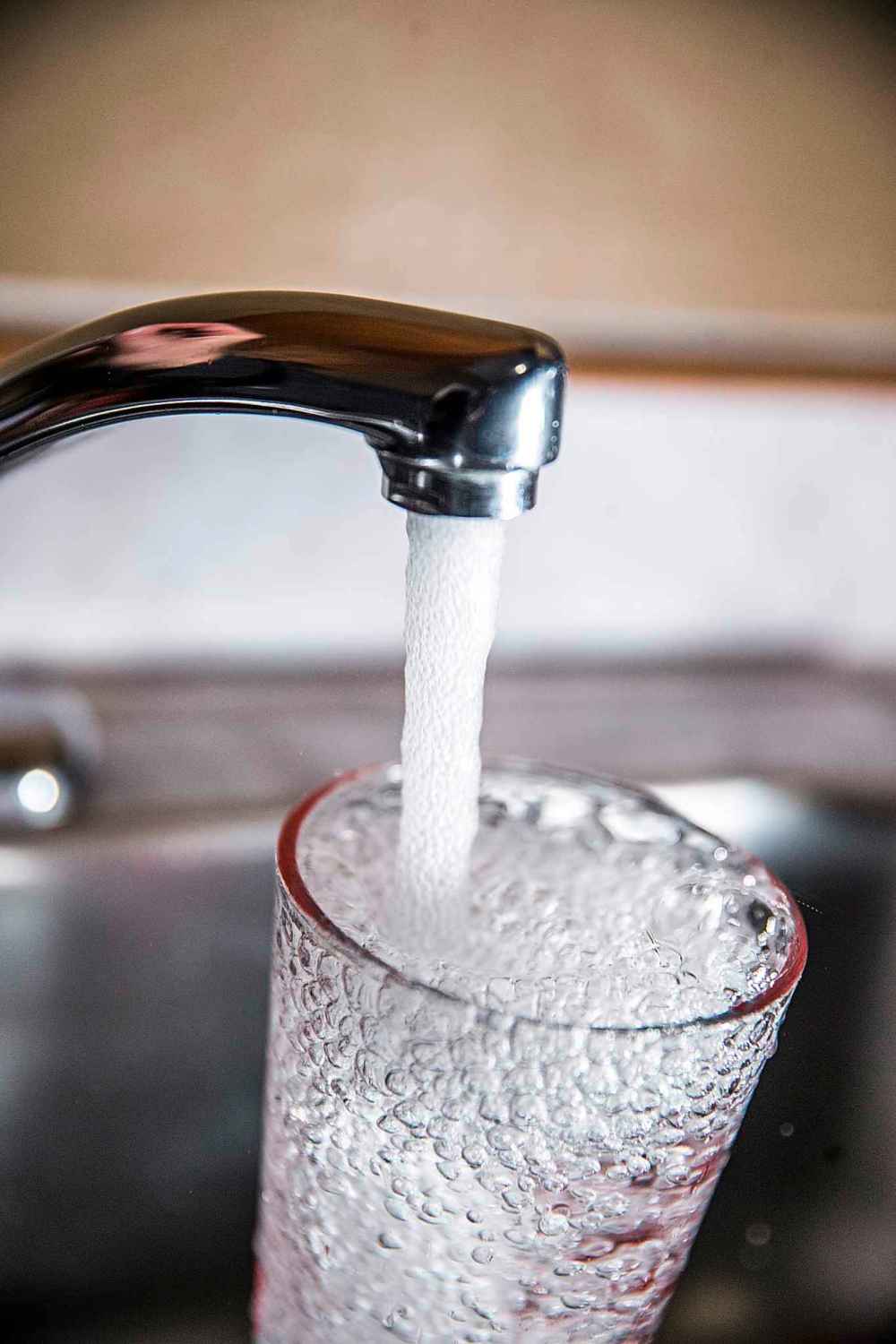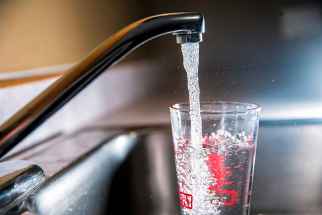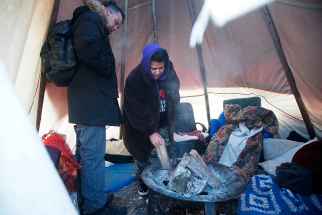Tests reveal unsafe lead levels in drinking water Highest concentration in Daniel McIntyre ward; city recommends flushing pipes
Read this article for free:
or
Already have an account? Log in here »
To continue reading, please subscribe:
Monthly Digital Subscription
$0 for the first 4 weeks*
- Enjoy unlimited reading on winnipegfreepress.com
- Read the E-Edition, our digital replica newspaper
- Access News Break, our award-winning app
- Play interactive puzzles
*No charge for 4 weeks then price increases to the regular rate of $19.00 plus GST every four weeks. Offer available to new and qualified returning subscribers only. Cancel any time.
Monthly Digital Subscription
$4.75/week*
- Enjoy unlimited reading on winnipegfreepress.com
- Read the E-Edition, our digital replica newspaper
- Access News Break, our award-winning app
- Play interactive puzzles
*Billed as $19 plus GST every four weeks. Cancel any time.
To continue reading, please subscribe:
Add Free Press access to your Brandon Sun subscription for only an additional
$1 for the first 4 weeks*
*Your next subscription payment will increase by $1.00 and you will be charged $16.99 plus GST for four weeks. After four weeks, your payment will increase to $23.99 plus GST every four weeks.
Read unlimited articles for free today:
or
Already have an account? Log in here »
Hey there, time traveller!
This article was published 17/12/2019 (2184 days ago), so information in it may no longer be current.
A random sample of tap water taken from homes across the city during the summer found that residents in seven wards had to leave their faucets running for a minimum of two minutes to ensure lead levels fell below national guidelines for safe drinking water.
More homes await tests
City hall was deluged in August for requests from residents to participate in lead-level testing after letters were sent out to more than 23,000 homeowners advising them of the possibility of lead in their water.
City hall was deluged in August for requests from residents to participate in lead-level testing after letters were sent out to more than 23,000 homeowners advising them of the possibility of lead in their water.
Participants were chosen on a first-come, first-served basis, limited initially to 200 homes in total that a spokesman said was later increased to 268 homes. There are about 2,300 homes now on a waiting list for a second round of testing, which is expected in the spring.
For the August testing, four samples were taken from each home — a random, daytime sample (no prior flushing), and three additional samples following flushings of one, two and five minutes.
An interactive map showing ward results of the lead sample testing can be found at: http://wfp.to/9nC
The results of the city’s random testing found that the greatest percentage of homes with lead levels exceeding the 0.005 milligrams per litre concentration is in St. Vital, where 50 per cent of homes exceeded the guideline for water taken straight from the tap without any flushing of the lines.
But the St. Vital sample was small — only two homes were tested — so the problem was confined to one home out of 665 homes in the ward known to have indoor lead pipes.
Testing in three wards — North Kildonan, Transcona and St. Boniface — found lead levels before flushing well below the national guidelines.
The city said that in only two wards — Old Kildonan and Waverley – are there no homes with lead pipes. No tests were conducted in those neighbourhoods.
In addition, tests were not conducted in Charleswood-Tuxedo-Westwood (45 homes with lead pipes) and St. Norbert-Seine River (one home).
Lead in Winnipeg’s tap water can originate from three main sources: indoor plumbing; the underground line on the property connecting a home to the city’s water main; and, lead fixtures and soldering.
The city’s website says lead pipes were more common in home construction until the mid-1950s but building-code standards allowed them until 1975.
— Staff
City hall conducted its water testing in August after Ottawa released new guidelines in the spring for lead levels in drinking water, slashing the standard in half to “maximum acceptable concentrations” of 0.005 milligrams per litre.
The greatest concentration of lead in tap water was found in Daniel McIntyre, where levels reached 0.10822 mg/L — 22 times the maximum allowable amount – for 17 per cent of the homes in the ward with lead pipes.
The city says almost one-quarter (23.77 per cent) of all Winnipeg homes with lead pipes are located in the Daniel McIntyre ward, where there are 5,496 homes.
“Absolutely, it does concern me. Anytime you have an exceedance of the guideline level, that is something that needs to be rectified,” said Eva Pip, a retired University of Winnipeg biology professor and local toxicologist whose research focuses on water quality.

(function() {
var paidAccessCheck = function(){
if($(“.paidaccess”).css(“display”) == “block”){
var elements = Array.prototype.slice.call(document.querySelectorAll(“.g-artboard[data-min-width]”)),
widthById = {};
elements.forEach(function(el) {
var parent = el.parentNode,
width = widthById[parent.id] || parent.getBoundingClientRect().width,
minwidth = el.getAttribute(“data-min-width”),
maxwidth = el.getAttribute(“data-max-width”);
widthById[parent.id] = width;
if (+minwidth = width || maxwidth === null)) {
el.style.display = “block”;
} else {
el.style.display = “none”;
}
});
try {
if (window.parent && window.parent.$) {
window.parent.$(“body”).trigger(“resizedcontent”, [window]);
}
if (window.require) {
require([‘foundation/main’], function() {
require([‘shared/interactive/instances/app-communicator’], function(AppCommunicator) {
AppCommunicator.triggerResize();
});
});
}
} catch(e) { console.log(e); }
clearInterval(verifyPaidAccess);
}
}
var verifyPaidAccess = setInterval(paidAccessCheck,500);
// only want one resizer on the page
if (document.documentElement.className.indexOf(“g-resizer-v3-init”) > -1) return;
document.documentElement.className += ” g-resizer-v3-init”;
// require IE9+
if (!(“querySelector” in document)) return;
function resizer() {
var elements = Array.prototype.slice.call(document.querySelectorAll(“.g-artboard[data-min-width]”)),
widthById = {};
elements.forEach(function(el) {
var parent = el.parentNode,
width = widthById[parent.id] || parent.getBoundingClientRect().width,
minwidth = el.getAttribute(“data-min-width”),
maxwidth = el.getAttribute(“data-max-width”);
widthById[parent.id] = width;
if (+minwidth = width || maxwidth === null)) {
el.style.display = “block”;
} else {
el.style.display = “none”;
}
});
try {
if (window.parent && window.parent.$) {
window.parent.$(“body”).trigger(“resizedcontent”, [window]);
}
if (window.require) {
require([‘foundation/main’], function() {
require([‘shared/interactive/instances/app-communicator’], function(AppCommunicator) {
AppCommunicator.triggerResize();
});
});
}
} catch(e) { console.log(e); }
}
document.addEventListener(‘DOMContentLoaded’, resizer);
// feel free to replace throttle with _.throttle, if available
window.addEventListener(‘resize’, throttle(resizer, 200));
function throttle(func, wait) {
// from underscore.js
var _now = Date.now || function() { return new Date().getTime(); },
context, args, result, timeout = null, previous = 0;
var later = function() {
previous = _now();
timeout = null;
result = func.apply(context, args);
if (!timeout) context = args = null;
};
return function() {
var now = _now(), remaining = wait – (now – previous);
context = this;
args = arguments;
if (remaining wait) {
if (timeout) {
clearTimeout(timeout);
timeout = null;
}
previous = now;
result = func.apply(context, args);
if (!timeout) context = args = null;
} else if (!timeout && options.trailing !== false) {
timeout = setTimeout(later, remaining);
}
return result;
};
}
})();
#g-winnipeg-lead-in-the-water-box ,
#g-winnipeg-lead-in-the-water-box .g-artboard {
margin:0 auto;
}
#g-winnipeg-lead-in-the-water-box p {
margin:0;
}
#g-winnipeg-lead-in-the-water-box .g-aiAbs {
position:absolute;
}
#g-winnipeg-lead-in-the-water-box .g-aiImg {
position:absolute;
top:0;
display:block;
width:100% !important;
}
#g-winnipeg-lead-in-the-water-box .g-aiSymbol {
position: absolute;
box-sizing: border-box;
}
#g-winnipeg-lead-in-the-water-box .g-aiPointText p { white-space: nowrap; }
#g-winnipeg-lead-in-the-water-mobile-small {
position:relative;
overflow:hidden;
}
#g-winnipeg-lead-in-the-water-mobile-small p {
font-weight:500;
line-height:9px;
height:auto;
filter:alpha(opacity=100);
-ms-filter:progid:DXImageTransform.Microsoft.Alpha(Opacity=100);
opacity:1;
letter-spacing:0em;
font-size:7px;
text-align:left;
color:rgb(0,0,0);
text-transform:none;
padding-bottom:0;
padding-top:0;
mix-blend-mode:normal;
font-style:normal;
position:static;
}
#g-winnipeg-lead-in-the-water-mobile-small .g-pstyle0 {
font-weight:700;
line-height:8px;
height:8px;
font-size:12px;
}
#g-winnipeg-lead-in-the-water-mobile-small .g-pstyle1 {
line-height:10px;
}
#g-winnipeg-lead-in-the-water-mobile-small .g-pstyle2 {
font-weight:700;
height:9px;
}
#g-winnipeg-lead-in-the-water-mobile-small .g-pstyle3 {
height:9px;
}
#g-winnipeg-lead-in-the-water-mobile-small .g-pstyle4 {
line-height:7px;
height:7px;
font-size:6px;
text-align:right;
}
#g-winnipeg-lead-in-the-water-mobile-small .g-cstyle0 {
font-weight:700;
}
#g-winnipeg-lead-in-the-water-mobile-small .g-cstyle1 {
font-weight:500;
}
#g-winnipeg-lead-in-the-water-mobile-large {
position:relative;
overflow:hidden;
}
#g-winnipeg-lead-in-the-water-mobile-large p {
font-weight:500;
line-height:11px;
height:auto;
filter:alpha(opacity=100);
-ms-filter:progid:DXImageTransform.Microsoft.Alpha(Opacity=100);
opacity:1;
letter-spacing:0em;
font-size:8px;
text-align:left;
color:rgb(0,0,0);
text-transform:none;
padding-bottom:0;
padding-top:0;
mix-blend-mode:normal;
font-style:normal;
position:static;
}
#g-winnipeg-lead-in-the-water-mobile-large .g-pstyle0 {
font-weight:700;
line-height:9px;
height:9px;
font-size:14px;
}
#g-winnipeg-lead-in-the-water-mobile-large .g-pstyle1 {
line-height:12px;
font-size:9px;
}
#g-winnipeg-lead-in-the-water-mobile-large .g-pstyle2 {
font-weight:700;
height:11px;
}
#g-winnipeg-lead-in-the-water-mobile-large .g-pstyle3 {
height:11px;
}
#g-winnipeg-lead-in-the-water-mobile-large .g-pstyle4 {
line-height:8px;
height:8px;
font-size:7px;
text-align:right;
}
#g-winnipeg-lead-in-the-water-mobile-large .g-cstyle0 {
font-weight:700;
}
#g-winnipeg-lead-in-the-water-mobile-large .g-cstyle1 {
font-weight:500;
}
#g-winnipeg-lead-in-the-water-desktop {
position:relative;
overflow:hidden;
}
#g-winnipeg-lead-in-the-water-desktop p {
font-weight:500;
line-height:12px;
height:auto;
filter:alpha(opacity=100);
-ms-filter:progid:DXImageTransform.Microsoft.Alpha(Opacity=100);
opacity:1;
letter-spacing:0em;
font-size:9px;
text-align:left;
color:rgb(0,0,0);
text-transform:none;
padding-bottom:0;
padding-top:0;
mix-blend-mode:normal;
font-style:normal;
position:static;
}
#g-winnipeg-lead-in-the-water-desktop .g-pstyle0 {
font-weight:700;
line-height:18px;
height:18px;
font-size:18px;
}
#g-winnipeg-lead-in-the-water-desktop .g-pstyle1 {
line-height:14px;
font-size:12px;
}
#g-winnipeg-lead-in-the-water-desktop .g-pstyle2 {
font-weight:700;
height:12px;
}
#g-winnipeg-lead-in-the-water-desktop .g-pstyle3 {
height:12px;
}
#g-winnipeg-lead-in-the-water-desktop .g-pstyle4 {
font-weight:700;
height:12px;
font-size:10px;
}
#g-winnipeg-lead-in-the-water-desktop .g-pstyle5 {
line-height:13px;
height:13px;
text-align:right;
}
#g-winnipeg-lead-in-the-water-desktop .g-cstyle0 {
font-weight:700;
}
#g-winnipeg-lead-in-the-water-desktop .g-cstyle1 {
font-weight:500;
}
#g-winnipeg-lead-in-the-water-desktop .g-cstyle2 {
font-weight:700;
font-size:10px;
}
#g-winnipeg-lead-in-the-water-desktop .g-cstyle3 {
font-size:10px;
}
/* Custom CSS */
.gi.ai2html {
margin-bottom: 1em;
}
.gi.ai2html p {
text-shadow: 1px 1px 0px rgba(255,255,255,0.7), -1px -1px 0px rgba(255,255,255,0.7), -1px 1px 0px rgba(255,255,255,0.7), 1px -1px 0px rgba(255,255,255,0.7);
}
.gi.ai2html #no-shadow p {
text-shadow: none !important;
}
@media screen and (max-width: 375px) {
#gi-1217-wyg-lead-water-mobile-small,
#gi-1217-wyg-lead-water-mobile-large,
#gi-1217-wyg-lead-water-desktop {
display: none;
}
#gi-1217-wyg-lead-water-mobile-small {
display: block;
}
}
@media screen and (min-width: 375px) and (max-width: 569px) {
#gi-1217-wyg-lead-water-mobile-small,
#gi-1217-wyg-lead-water-mobile-large,
#gi-1217-wyg-lead-water-desktop {
display: none;
}
#gi-1217-wyg-lead-water-mobile-large {
display: block;
}
}
@media screen and (min-width: 570px) {
#gi-1217-wyg-lead-water-mobile-small,
#gi-1217-wyg-lead-water-mobile-large,
#gi-1217-wyg-lead-water-desktop {
display: none;
}
#gi-1217-wyg-lead-water-desktop {
display: block;
}
}

Testing for lead in Winnipeg’s water supply
In August, the City of Winnipeg offered to test for lead in the drinking water of approximately 23,000 homes.
Manitoba’s Office of Drinking Water required 200 tests from the city and this quota was quickly reached. The results, released in December, identify several neighbourhoods where lead levels exceeded the federal guidelines of 0.005 mg/L.
Fort Rouge – East Fort Garry
2,526 homes with lead pipes
51 tested, 27.5% of tests above guidelines
Max: 0.036960 mg/L
After 1 minute flush: 0.045937 mg/L
Point Douglas
3,009 homes with lead pipes
16 tested, 25% of tests above guidelines
Max: 0.013345 mg/L
After 1 minute flush: 0.014751 mg/L
Elmwood – East Kildonan
2,755 homes with lead pipes
16 tested, 31.3% of tests above guidelines
Max: 0.044972 mg/L
After 1 minute flush: 0.012455 mg/L
Daniel McIntyre
5,496 homes with lead pipes
83 tested, 16.9% of tests above guidelines
Max: 0.028998 mg/L
After 1 minute flush: 0.10822 mg/L
Winnipeg Free Press Source: City of Winnipeg
Updated December 20, 2019

Testing for lead in Winnipeg’s water supply
In August, the City of Winnipeg offered to test for lead in the drinking water of approximately 23,000 homes.
Manitoba’s Office of Drinking Water required 200 tests from the city and this quota was quickly reached. The results, released in December, identify several neighbourhoods where lead levels exceeded the federal guidelines of 0.005 mg/L.
Fort Rouge – East Fort Garry
2,526 homes with lead pipes
51 tested, 27.5% of tests above guidelines
Max: 0.036960 mg/L
After 1 minute flush: 0.045937 mg/L
Point Douglas
3,009 homes with lead pipes
16 tested, 25% of tests above guidelines
Max: 0.013345 mg/L
After 1 minute flush: 0.014751 mg/L
Elmwood – East Kildonan
2,755 homes with lead pipes
16 tested, 31.3% of tests above guidelines
Max: 0.044972 mg/L
After 1 minute flush: 0.012455 mg/L
Daniel McIntyre
5,496 homes with lead pipes
83 tested, 16.9% of tests above guidelines
Max: 0.028998 mg/L
After 1 minute flush: 0.10822 mg/L
Winnipeg Free Press Source: City of Winnipeg
Updated December 20, 2019

Testing for lead in Winnipeg’s water supply
In August, the City of Winnipeg offered to test for lead in the drinking water of approximately 23,000 homes.
Manitoba’s Office of Drinking Water required 200 tests from the city and this quota was quickly reached. The results, released in December, identify several neighbourhoods where lead levels exceeded the federal guidelines of 0.005 mg/L.
Fort Rouge – East Fort Garry
2,526 homes with lead pipes
51 tested, 27.5% of tests above federal guidelines
Max: 0.036960 mg/L
After 1 minute flush: 0.045937 mg/L
Point Douglas
3,009 homes with lead pipes
16 tested, 25% of tests above federal guidelines
Max: 0.013345 mg/L
After 1 minute flush: 0.014751 mg/L
Elmwood – East Kildonan
2,755 homes with lead pipes
16 tested, 31.3% of tests above federal guidelines
Max: 0.044972 mg/L
After 1 minute flush: 0.012455 mg/L
St. James
558 homes with lead pipes
8 tested, 37.5% of tests above federal guidelines
Max: 0.011710 mg/L
River Heights
1,905 homes with lead pipes
62 tested, 11.3% of tests above federal guidelines
Max: 0.010381 mg/L
After 1 minute flush: 0.019694 mg/L
Mynarski
4,971 homes with lead pipes
25 tested, 20% of tests above federal guidelines
Max: 0.014615 mg/L
After 1 minute flush: 0.009642 mg/L
St. Vital
665 homes with lead pipes
2 tested, 50% of tests above federal guidelines
Max: 0.006250 mg/L
After 1 minute flush: 0.005469 mg/L
Daniel McIntyre
5,496 homes with lead pipes
83 tested, 16.9% of tests above federal guidelines
Max: 0.028998 mg/L
After 1 minute flush: 0.10822 mg/L
Winnipeg Free Press Source: City of Winnipeg
Updated December 20, 2019
Lead is a neurotoxin that can affect the nervous system if inhaled or ingested. Exposure to high levels can cause kidney and brain damage; it is especially of concern to children’s health because their brains are developing.
A close examination of the testing results found that lead was present in eight city wards, and in seven of them — St. Vital, Elmwood-East Kildonan, Fort Rouge-East Fort Garry, Point Douglas, Mynarski, River Heights-Fort Garry and Daniel McIntyre — the taps had to be flushed a minimum of two minutes in some homes to record levels below the federal guideline.
St. James was the only area where the sample homes — eight — tested below the guideline after one minute.
Results of lead testing
See the results of lead testing for all samples overall, and by ward.
The City of Winnipeg has approximately 23,000 homes with lead pipes. Between August 15 and November 19, 2019, water samples from 268 homes with lead pipes were tested.
Federal guidelines for lead are 0.005 mg/L.
Random daytime tests (best estimate of lead levels in a home)
Average: 0.003486
Maximum found: 0.044972
Samples above guideline: 20.1 per cent
After flushing taps for one minute
Average: 0.002866
Maximum found: 0.108220
Samples above guideline: 11.5 per cent
Results by ward
Numbers of homes with lead pipes is approximate. Results provided only if samples exceeded federal guideline of 0.005 mg/L. For full results visit the city’s website.
Charleswood-Tuxedo-Westwood
Homes with lead pipes: 45
Homes tested: 0
Daniel McIntyre
Homes with lead pipes: 5,496
Homes tested: 83
Tested homes above guidelines: 16.9 per cent
Max lead amount: 0.028998 mg/L
After 1 minute flush: 0.10822 mg/L (8.4 per cent of tested)
Elmwood-East Kildonan
Homes with lead pipes: 2,755
Homes tested: 16
Tested homes above guidelines: 31.3 per cent
Max lead amount: 0.044972 mg/L
After 1 minute flush: 0.012455 (25 per cent of tested)
Fort Rouge – East Fort Garry
Homes with lead pipes: 2,526
Homes tested: 51
Tested homes above guidelines: 27.5 per cent
Max lead amount: 0.036960 mg/L
After 1 minute flush: 0.045937 mg/L (11.8 per cent of tested)
Mynarski
Homes with lead pipes: 4,971
Homes tested: 25
Tested homes above guidelines: 20 per cent
Max lead amount: 0.014615 mg/L
After 1 minute flush: 0.009642 mg/L (8 per cent of tested)
North Kildonan
Homes with lead pipes: 183
Homes tested: 1
Tested homes above guidelines: 0 per cent
Old Kildonan
Homes with lead pipes: 0
Point Douglas
Homes with lead pipes: 3,009
Homes tested: 16
Tested homes above guidelines: 25 per cent
Max lead amount: 0.013345 mg/L
After 1 minute flush max: 0.014751 (12.5 per cent of tested)
River Heights-Fort Garry
Homes with lead pipes: 1,905
Homes tested: 62
Tested homes above guidelines: 11.3 per cent
Max lead amount: 0.010381 mg/L
After 1 minute flush: 0.019694 mg/L (12.9 per cent of tested)
St. Boniface
Homes with lead pipes: 489
Homes tested: 2
Tested homes above guidelines: 0 per cent
St. James
Homes with lead pipes: 558
Homes tested: 8
Tested homes above guidelines: 37.5 per cent
Max lead amount: 0.011710 mg/L
St. Norbert
Homes with lead pipes: 1
Homes tested: 0
St. Vital
Homes with lead pipes: 665
Homes tested: 2
Tested homes above guidelines: 50 per cent
Max lead amount: 0.006250 mg/L
After 1 minute flush: 0.005469 (50 per cent of tested)
Transcona
Homes with lead pipes: 518
Homes tested: 2
Tested homes above guidelines: 0 per cent
Waverley West (St. Charles)
Homes with lead pipes: 0
Source: City of Winnipeg
In a release Tuesday morning, the city said that despite the findings from the sampling, “Winnipeg’s drinking water is safe.”
The city says there is no detectable lead in Shoal Lake, the source of piped water for all of Winnipeg, and a food-grade phosphoric acid is added to the water in the treatment process to prevent lead from entering the water through pipe corrosion.
“It’s not the water that’s going into the pipe that’s unsafe. It’s the water that’s in your home, that’s sitting in the pipes — I wouldn’t say it’s unsafe, it’s just recommended not to drink it,” Renee Grosselle, the city’s manager of environmental standards, told reporters during an afternoon news conference at the water and waste department offices.
“Overall, the results are as expected. Samples that were taken in… homes with lead pipes, there were a few that had some results over the guideline. However, on average, for the city, the results were below the guideline. They were about an average of 0.003, 0.004 (mg/L)."

Grosselle reiterated that as evidenced by the results, flushing is one of the best ways to reduce lead in drinking water. “You can take a shower before you drink out of the tap, you can do a load of laundry," she said.
She added that despite some results of lead levels surpassing the national guideline, Winnipeg is "ahead of the curve" compared to other municipalities because of its treatment program, which has been used since 2000.
The city says about 13 per cent of Winnipeg’s total housing stock has lead pipes but Pip said the number is likely much higher since the city doesn’t have reliable historical records. She said there’s a need to conduct more testing to find out how widespread the problem actually is.
In the United States, the Environmental Protection Agency requires water utilities to take corrective action if lead levels exceed safe guidelines in 10 per cent of samples or more.
Winnipeg said its August testing found 54 homes (20 per cent of those sampled) had lead levels above the national guideline before flushing the taps.
aldo.santin@freepress.mb.ca
maggie.macintosh@freepress.mb.ca

Maggie Macintosh reports on education for the Winnipeg Free Press. Funding for the Free Press education reporter comes from the Government of Canada through the Local Journalism Initiative.
Our newsroom depends on a growing audience of readers to power our journalism. If you are not a paid reader, please consider becoming a subscriber.
Our newsroom depends on its audience of readers to power our journalism. Thank you for your support.
History
Updated on Tuesday, December 17, 2019 8:23 PM CST: Fixes typo
Updated on Friday, December 20, 2019 3:15 PM CST: Corrects maximum test result for Daniel McIntyre
Updated on Friday, December 20, 2019 6:40 PM CST: Corrects maximum concentration for Daniel McIntyre










